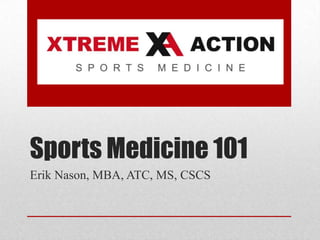
Xtreme Action Sports Medicine Presents: Sports Medicine 101
- 1. Sports Medicine 101 Erik Nason, MBA, ATC, MS, CSCS
- 2. Xtreme Action Sports Medicine
- 3. RODEO Xtreme Action Sports Medicine
- 4. Wakeboarding Xtreme Action Sports Medicine
- 5. Motorsports Xtreme Action Sports Medicine
- 6. • Understanding your body • Understanding the physical and psychological side of an injury • How does inflammation effect recovery • Differential diagnosis • Quick overview of two key body parts: the spine and shoulder • Do you use ICE or HEAT • Stretching and how it works Sports Medicine 101 Xtreme Action Sports Medicine
- 7. • • • • • • Lose weight Increase strength Simply become more physically active Overall better health The thrill of something new Competition/Personal Challenge What are your goals? Xtreme Action Sports Medicine
- 8. • • • • • • • Pain and exercise High speed, high impact can cause injury - fact Careful not to push your body to fatigue….regularly Don’t compromise form for speed and numbers Vomiting and exercise Continued inflammation The older you get, the longer it takes to heal Listen To Your Body Xtreme Action Sports Medicine
- 9. • The body’s response to injury. • Beginning stage to healing. • 5 cardinal signs of inflammation: • • • • • Heat Redness Swelling Pain Loss of Range of Motion Inflammation Xtreme Action Sports Medicine
- 10. Xtreme Action Sports Medicine
- 11. Xtreme Action Sports Medicine
- 12. Xtreme Action Sports Medicine
- 13. Xtreme Action Sports Medicine
- 14. Xtreme Action Sports Medicine
- 15. • • • • • • Anterior Shoulder Pain = Rotator Cuff Impingement Low Back Strain = Facet Joint Syndrome Plantar Fasciitis = Trigger Points in Posterior Tib Muscle Sciatic = Herniated Disc Cervical Disc Herniation = Thoracic Outlet Syndrome Anterior Knee Pain = Lateral Retinaculum Adhesions Differential Diagnosis Xtreme Action Sports Medicine
- 16. Xtreme Action Sports Medicine
- 17. • What does ICE do? • Constricts blood vessels to decrease blood flow • Decreases Inflammation • Decreases muscle spasms • Decreases pain • What does HEAT do? • Increases blood flow to treatment area for healing • Improves flexibility and stretching abilities • Relaxes soft tissue (muscles) Ice vs. Heat Xtreme Action Sports Medicine
- 18. Use Ice Use Heat • Acute injury (new) • Presences of swelling, discoloration, and loss of function. • Pain • Contusions • First degree burns • Pain has diminished • No presence of discoloration or swelling. • Chief Complaint: stiffness, loss of ROM Ice vs. Heat Xtreme Action Sports Medicine
- 19. ICE HEAT • Ice Pack – 15-20 Minutes • Ice Bath – 15-20 Minutes • Moist Heat Packs - 15-30 Minutes • Warm Bath (100-105dg) • For extremities (52dg) • Ice Cup (massage) 7-10 Minutes • RICE Ice vs. Heat Xtreme Action Sports Medicine • 15-20 minutes • Dry Heat Pad – 15 -20 Minutes
- 20. Tips on Stretching Xtreme Action Sports Medicine
- 21. • How does a muscle work? • Muscle guarding – Protection • Stretching muscles means you are lengthen nerves too Stretching Xtreme Action Sports Medicine
- 22. • Do not bounce! • Slow steady hold. Hold for at least 20 seconds. Repeat 3-5 times. • Stretches are more effective after a warm up. • Protect your joints when stretching. • Breathe normally when stretching. • Cool down and stretch post exercise. • You shouldn’t be in pain. Go until you feel a moderate stretch and hold it. Repeat. Each repetition you should go further. Tips on Proper Stretching Xtreme Action Sports Medicine
- 23. The Shoulder Xtreme Action Sports Medicine
- 24. Xtreme Action Sports Medicine
- 25. Xtreme Action Sports Medicine
- 26. Xtreme Action Sports Medicine
- 27. Xtreme Action Sports Medicine
- 28. Xtreme Action Sports Medicine
- 29. Current Concepts in the Treatment of Impingement Problems 75% of shoulder impingements are treated non-operatively Classical pinching of anterior or superior rotator cuff or bursa manifested by pain Xtreme Action Sports Medicine
- 30. Shoulder Impingement • Saran wrap folded on itself with oil between layers • 1/3 have down slopping acromions • Anterior 1/3 create impingement Xtreme Action Sports Medicine
- 31. 4 Major Curves in the Spine • 7 Cervical Vertebra • Forward curve (lordosis) • 12 Thoracic Vertebra • Backward curve (kyphosis) • 5 Lumbar Vertebra • Forward curve (lordosis) • Coccyx • Backward curve (kyphosis) Lifting and Back Injuries Xtreme Action Sports Medicine
- 32. Discs Xtreme Action Sports Medicine
- 33. Shock Absorber Spacer Role of the Disc Xtreme Action Sports Medicine
- 34. Damaging Disc Life Caused by both repetitive stress and microtrauma Faulty posture and inflexibility Poor lifting mechanics Most common at L4/L5 and L5/S1 Xtreme Action Sports Medicine
- 35. Degenerative Disc Disease First X-Ray Xtreme Action Sports Medicine 20 Years Later
- 36. Herniated Discs Xtreme Action Sports Medicine
- 37. Radiating Pain Xtreme Action Sports Medicine
- 38. • • • • • • Understanding your body – makes you a healthier person. Listen to your body – it doesn’t lie. No Pain, No Gain is not true for strength training Inflammation won’t go away- cause you won’t let it! Recovery and Rest are ignored but key to injury healing. Active Rest – Requires exercise modification, not stopping. Take Home Points Xtreme Action Sports Medicine
- 39. THANK YOU!!!!! • What questions do you have? • What topics would you like to learn about? What Questions Do You Have? Xtreme Action Sports Medicine
- 40. • • • • www.xtremesportsmed.com Facebook: XtremeActionSportsMedicine Twitter: XtremeSportsMed Instagram: XtremeActionSportsMedicine FOR MORE INFO Xtreme Action Sports Medicine
Editor's Notes
- Two types of patients – PFP pt….just stopped everything…. TFCC pt ----when back to early.
